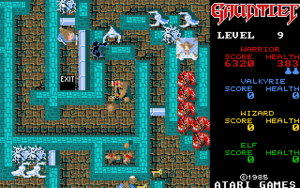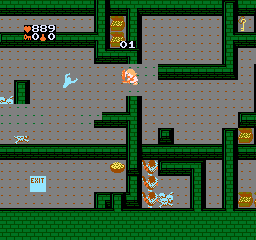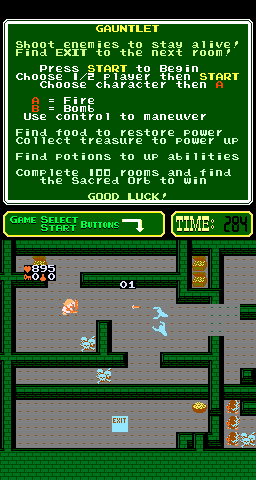(→NES: adding screen, reworking description) |
(→Atari ST: adding screenie+desc) |
||
| Line 8: | Line 8: | ||
{{sect-stub}} | {{sect-stub}} | ||
==Atari ST== | ==Atari ST== | ||
{{ | [[Image:Gauntlet Atari ST.png|thumb|left|Atari ST]] | ||
Developed by Atari Games Corporation and released by Mindscape Inc. in 1987. | |||
{{-}} | |||
==Commodore 64== | ==Commodore 64== | ||
{{sect-stub}} | {{sect-stub}} | ||
Revision as of 05:56, 30 October 2006
Amstrad CPC
Apple II
Atari 8-bit
Atari ST

Developed by Atari Games Corporation and released by Mindscape Inc. in 1987.
Commodore 64
MS-DOS
J2ME
Sinclair ZX Spectrum
MSX
NES

Like the later Sega Genesis version, the NES version takes the "more than a port" route. It replaces the original level set with an entirely new array of even less linear levels, complete with world maps like those of Super Mario Bros. 3, allowing the player to plot their course through the game. There is also new music, and many new items. It also adds an actual storyline, which even explains why only two can play simultaneously.
Among the sacrifices made in the conversion are significantly reduced graphics, support for only two players, and no narration (character voices heard when hurt or eating remain).
PlayChoice-10

The NES version later returned to the arcade as a game for Nintendo's PlayChoice-10 hardware. The only real changes (other than the time limit imposed by the PlayChoice-10 hardware itself) were a slightly larger game area and additional help tips at the top.
Sega Master System
Game Boy Advance
Sega Genesis
Released by Tengen in 1993 as part of Gauntlet IV. True to its name, Gauntlet IV was more than just a port; in addition to the original game recreated as faithfully as the technology allows it also includes Record Mode (where players can track more detailed high scores and save/restore their game), Battle Mode (where players can face off in a randomly-selected arena), and also Quest Mode, an all-new RPG that extends the Gauntlet mechanics to include money, EXP gain and more inventory items.
Xbox Live Arcade
This is no mere port; like other Xbox Live Arcade titles, this version includes upscaled graphics (approximately 64x64, compared to the original's comparitively small 16×16)
